Whole genome sequencing approaches are rapidly becoming more accessible and gaining popularity. The development of powerful analytical tools for these data has enabled novel approaches to answering outstanding evolutionary questions. Yann Bourgeois, a post-doc at NYU- Abu Dhabi, is the first to take a whole genome approach to understand the population genomics of Anolis carolinensis in the southeastern United States. Yann presented his work in a poster at Evolution 2018 in Montpellier.
Yann sequenced 27 individuals from across the native range representing the five unique genetic clusters (Gulf Atlantic, Carolinas, North Eastern Florida, North Western Florida, South Florida). He found that the Gulf Atlantic and Carolina populations were nested within the Florida populations, supporting the hypothesis of a northward expansion from southern Florida. He was able to estimate that this colonization of regions north of Florida likely occurred in the past 100,000 years. Interestingly, he also found that this dispersal event was associated with a reduction in X chromosome diversity, suggesting that dispersal was either male biased or that there has been positive selection on the X chromosome.

Whole genome sequencing of 27 individuals from across the native range reveals population genetic structure
Taking this one step further, Yann then investigated patterns of recombination via secondary contact among the genetic clusters. Yann and his colleagues found that there has been gene flow between clusters over periods of secondary contact with interspersed periods of isolation. Limited introgression between Florida and the northern populations suggests local adaptation in the northern populations.
Yann and his colleagues have provided an interesting first look at the evolutionary history of Anolis carolinensis from a genomic perspective. The revealed patterns of expansion, reduced diversity, isolation, and secondary contact raise interesting questions about the origin of new genetic clusters (and perhaps species) and their maintenance with ongoing or periodic gene flow.
For more information on this exciting research, check out the pre-print of the manuscript.
- Puerto Rico Herpetology Symposium - September 21, 2023
- Anole Symposium This Fall? - July 14, 2023
- Parallel Urban Adaptation from Phenotype to Genotype in Anolis Lizards - January 20, 2023



Leave a Reply